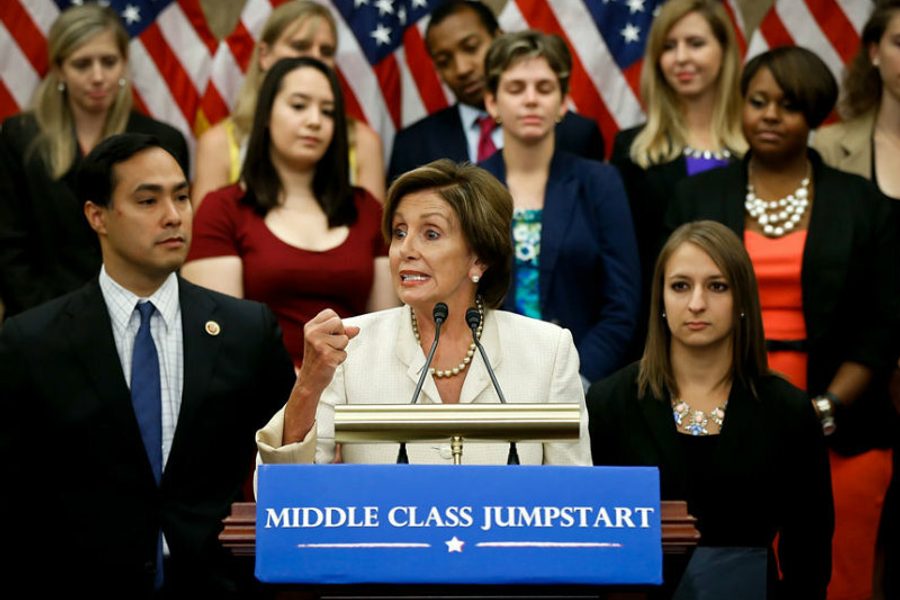
Midterm elections are, above all, mid — a mile marker plunked between the two main-event presidential contests. Sometimes, the pundit class declaims, they act as a referendum on the present occupant of the Oval Office. But beyond that, they’re viewed as exercises in major-party housekeeping — opportunities to pick off a vulnerable seat or three, and perhaps to nudge local political talent closer to the national stage.
Still, the 2014 midterm cycle looks especially mid — and distinctly sub-mid for Democrats, who not long ago commanded sizable majorities in the House and Senate. Things look so grim that the Democratic Party leadership is challenged in simply maintaining a surface appearance of unity. As the New York Times reported in mid-August, even longtime congressional allies of the Obama White House such as Sen. Claire McCaskill (D-Mo.) freely concede that the president has little to no interest in working closely with House and Senate leaders. Meanwhile, House Minority Leader Nancy Pelosi, who is supposed to be maintaining a samurai-like focus on regaining her Speakership in the next Congress, has told reporters she’d readily surrender the leadership post for the sake of passing immigration reform.
On one level, the challenge for the Democrats might be stated simply: Where are the Elizabeth Warrens of 2014? Sen. Warren (D-Mass.), of course, was the presumptive nominee to head the Obama White House’s new office of consumer finance oversight. When the GOP Congress deemed her too brashly populist for the post — i.e., too prone to actually regulate the industry — Warren was denied the nomination. Instead of seeking out a lobbying sinecure in the tradition of most cashiered D.C. regulators, Warren got fighting mad, and was elected to the Senate in 2012. She’s now riding a wave of popularity that may portend an insurgent presidential candidacy that would disrupt the neoliberal coronation of Hillary Clinton as the party’s 2016 nominee.
There are a few scattered Warren-like signs of life this cycle — notably Ruben Gallego’s populist capture of the Democratic nomination for Arizona’s 7th congressional district, backing a government- administered public option for universal healthcare and spotlighting income inequality. But such wins are a long way from translating into a winning House strategy. Gallego will likely cruise to victory in November, because his district is heavily Democratic. But to put more House districts in play means the Democrats would have to successfully harness a populist economic message to reach constituencies that haven’t lately broken Democratic — lower-middle-class white families, rural voters and the like. “By definition, if you want to go from the minority to the majority, you want to win over a group of voters from the other side,” says Michael Lind, policy director of the New America Foundation, a D.C.-based thinktank. “You can win over the pro-New Deal creationists, or the socially liberal Christian conservatives. But by definition, those people are not going to agree with you on your own personal issues.”
That the Democrats should be this far away from homing in on any sort of majoritarian message is an unusual situation. Historically, midterm cycles have been crucial for shoring up power on the Democratic side of the aisle. In 1982, for example, a resurgent House Democratic majority fresh from major gains in the midterms passed the Boland amendment, forbidding American aid to the Nicaraguan Contras — and thereby laid the groundwork for the Iran-Contra scandal that hamstrung the Reagan administration and came close to endangering the presidency itself. Similarly, the 1974 “Watergate class” of reformist Democrats passed the first wave of campaign-finance legislation to curb the uglier abuses of the election system by moneyed interests.
Over and above such signature reform movements, Democratic Congresses were integral to the New Deal and Great Society eras of lawmaking, whose popular initiatives in turn solidified what became known as the Democratic majority — the coalition of union members, movement liberals, and urban white “ethnic,” black and brown voters that comprise the backbone of the Democratic Party. These voters sustained and nourished the later Democratic Congresses that extended the basic terms of New Deal governance via landmark legislation such as the GI Bill, Medicare, Medicaid, the Voting Rights Act, the Civil Rights Act and the raft of workplace and environmental protections legislated into being from the 1970s onward. The voting majorities behind the postwar Democratic domination of Congress should have, on paper, continued to expand in tandem with the vital expansions of income supports and civil-rights protections that these Congresses managed, however narrowly, to enact. While the civil rights legislation did famously sacrifice big blocs of Democratic white voters in the formerly solid South, the party was well-positioned to build on the New Deal coalition in the House — the chamber of Congress most responsive to populist governance. Conditions should have been ripe for an enduring, if not permanent, Democratic majority — which would have helped sustain the party’s populist image as the defender of ordinary working Americans against the big-money agenda of the GOP. Instead, the Right knitted together the overlapping insurgencies of the small government tax revolt and the middle- and working-class infantry of the evangelical culture wars.
But such historical shifts don’t fully explain how the Democrats went from huge House and Senate majorities as recently as 2008 to the glum prospects they face in 2014: almost certain losses for an already beleaguered House minority and a likelihood that a more unified GOP will take back the Senate. The way to combat a bad electoral map is via a robust majoritarian strategy, and the Democrats have none.
The Pollyannas of Capitol Hill
Democratic Party elites of course won’t confess to the bleakness awaiting them on November 4. Their job is to stoke the dream of an 11th-hour comeback for their team, so as to raise turnout and (more important) campaign dollars right up until Election Day. As a result, pre-election fundraising appeals from the Democratic Legislative Campaign Committee lurch between apocalyptic brow beating — “President Obama’s impeachment could soon be a reality if we don’t step up in a BIG way” — and tortured explanations of GOP connivance: “They want us to get so discouraged that we stop fighting back.” Are the Republicans power-mad impeachers, or lame psych-out artists? Were these nearhourly email shakedowns taken literally, the model Democratic donor would be a paranoid megalomaniac.
One could discount such oscillating outcries as off-the-rack fundraising rhetoric seeking a contribution by any means necessary. But the actual Democratic agenda in Congress suffers from a similar harum-scarum incoherence. Party leaders gin up disingenuous “populist” appeals to goose up turnout, but then revert by instinct to the New Economy complacency of the party’s actual donor base — a congeries of Silicon Valley, Wall Street and corporate backers that differs from the GOP donor base mainly by promoting more progressive social attitudes.
For instance, in July, Democratic leaders trotted out a slapdash Democratic version of the Contract with America— the legislative compact that permitted the right-wing Gingrich insurgency in Congress to successfully market its own agenda in pseudo-populist terms 20 years ago. Called the “100-Day Action Plan,” this legislative package spelled out some unobjectionable, unambitious economic stimulus proposals that House Democrats would introduce on the off-chance they regain their majority. They would, for example, increase federal spending on infrastructure repair, push for an increase in the minimum wage, allow more college grads to refinance their student loans at a lower rate and spend more on early childhood learning programs.
Tellingly, the lead congressional backers of this package did not depict it as a vindication of the grievances of disenfranchised workers, debtors, homeowners and students. No, by sheer force of habit — and in pointed concert with the priorities of the Democratic Party’s bigmoney donor class the media rollout of the 100 Day Action Plan brimmed with the smug and technocratic argot of Silicon Valley and Wall Street. As Pelosi nonsensically announced to the assembled Beltway press: “This is a tribute to American entrepreneurship [and] a recognition that innovation begins in the classroom. Our agenda for women and families is when women succeed, America succeeds.”
Indeed, the Action Plan was further spun as an effort to “jumpstart the middle class” — thereby evoking an unfortunately ominous and clinical image of this lumpy cross-section of striving Americans as a sort of slumbering Frankenstein.
This suggestion that we need more Democratic lawmakers to power the electrodes raises, in turn, the awkward supposition that the same body of legislators were largely responsible for allowing the middle class’s batteries to die out in the first place.
That impression is not far off the mark. Democratic lawmakers have collaborated on lavish giveaways to the Silicon Valley venture capital crowd such as the laughably mistitled 2012 JOBS Act (that would be JOBS as in “Jumpstart Our Business Startups”). But when it comes to either combating the scourge of economic inequality or holding the nation’s plutocrats to account, the House Democratic caucus, with a few exceptions, has been largely AWOL.
Progressive staffers on Capitol Hill have watched this abdication in a mixture of anger and disbelief. “The Democrats don’t want to govern,” says one Democratic House aide, who requested anonymity in order to speak freely. “Look, in 2006, when they were elected into the majority on the basis of ending the war in Iraq, the first thing they did was to fund Bush’s surge of forces in Iraq. They just don’t want to govern. They don’t see that as their job.”
Then, the aide notes, came the historic 2008 financial meltdown, which coincided with an election cycle that returned the biggest Democratic majorities to Congress in 15 years. “There was an opportunity to reorganize our whole political culture after the 2008 crisis. Even under those conditions, there was still no willingness to do much.” A dramatic case in point, the aide says, was the failed struggle from 2008 to 2010 to put teeth in the Dodd-Frank banking reform package. “Rather than breaking up the banks or writing clear law or prosecuting bankers, Democrats deferred to bank-captured regulators. Then they play-act surprise when bank profits return to record levels. It’s Kabuki.”
The same goes for the White House’s on-again and (usually) off-again effort to remedy the runaway increase in income inequality. In his 2014 State of the Union address, Obama cited income inequality as the defining challenge of our time and announced his intention to increase the minimum wage for federal contractors. Then he challenged businesses in the private sector to do likewise. The glum epilogue, as the aide notes, has been no appreciable boost in wages in 2014 for U.S. workers. The aide concludes, “There’s this huge irrelevance gap between what Democratic elites say, and what any outcome will be.”
Thomas Ferguson, the University of Massachusetts political scientist who pioneered the investment theory of campaign funding in his 1995 book Golden Rule, argues that such feeble feints at economic reform are policy payoffs for a Democratic lawmaking apparatus that’s grown dependent on big-money outlays from the financial sector, the barons of Silicon Valley and other assorted plutocrats.
“These guys are living out the legacy of the enormous failures of 2009,” Ferguson says. “Everything still stands in the shadow of 2009. Had Obama done a proper stimulus then, had Dodd-Frank actually brought bankers to justice, the Democrats would not be in this situation now.”
Speaking of Kabuki, Ferguson, too, has an edifying minimum wage anecdote. “A friend of mine on the Hill was telling me this story that, when Reid was trying to get a vote going to raise the minimum wage, Pelosi said outright, ‘I know that Harry Reid doesn’t want a vote on this.’ That’s where we are today,” he says. “This is the funding of the Democratic Party, together with the even more top-heavy funding of the White House, ensuring that the status quo holds. And when you paralyze the Democratic president from acting even a little bit like a Democrat, Democrats are not going to be credible voices of reform… This is part of an all-time historic collapse of governing that will cast a shadow for a decade or more.”
Of course, Democrats face other obstacles in advancing a winning strategy to reclaim the House in November — the factors that election wonks call “structural,” such as the gerrymandering of safe Republican districts by Republican dominated state legislatures. But structural forces are, by definition, the very factors that effective majoritarian strategies are crafted to overcome. The GOP overcame much the same set of obstructions in its successful takeover of the House in 2010 — the year that the Tea Party, and its corporate backers, stepped into the political limelight. What’s more, gesturing at the implacable power of GOP-run state legislatures raises the question of just how the Democrats — the historic grassroots party of the people, operating with the enormous advantage of a crippling recession occurring on the Republicans’ executive watch — have been unable to summon their own majorities in so many state legislatures. (That answer — yet again — resides in a decided GOP tactical advantage rooted in long-term conservative organizing initiatives at the state and grassroots levels.)
Meanwhile, when it comes to the allocation of resources within the party, the top-heavy nature of Democratic campaign funding once more distorts the party’s priorities. The Democratic Congressional Campaign Committee “sucks in terms of their targeting,” says a veteran Democratic Hill aide, who also requested anonymity. “Just look at how few races the DCCC targets, and how much money is lavished on those happy few candidates who are targeted, in many cases far more than can be wisely spent. [Party leaders are] wasting finite dollars that could more wisely be spent trying to develop races that might prove winnable, and once in that category, might actually be won.”
If this complaint sounds familiar, that’s because it is. Before the 2006 Democratic wave, the head of the DCCC, Illinois House member Rahm Emanuel, was locked in battle with Democratic National Committee chairman Howard Dean over Dean’s ambitious “50-state strategy.” The Dean plan sought to put Democratic candidates into competitive play everywhere, as opposed to the traditional coastal, urban and upper-Midwestern strongholds of Democratic congressional power. Emanuel, a member of the investment-banking fraternity who had been charged with shepherding in bundled big-money donations, contended that such far-flung organizing efforts were unrealistic — and thus a strain on the party’s bulging campaign coffers. He got the better of the argument, and after the 2006 cycle, the 50-state strategy was shelved — and Dean was sent packing.
Eight years later, it’s hard not to conclude that the party would be far better off if it had followed Dean’s lead and pressed its already formidable advantages in 2006 into districts that now look like nearly permanent “red state” power bases. A 2013 study in Governing magazine found that even the partial implementation of the Dean plan yielded quite encouraging results for the Democrats. In the 20 red states covered in the survey, “Democratic candidates chalked up modest successes, despite the difficult political terrain,” the Governing team found. “Then, after the project stopped, Democratic success rates cratered.” In other words, in heeding Emanuel’s counsel to follow the big money, Democrats are getting exactly what they paid for.
‘Dialing for dollars’
Still, even the savviest ground game won’t jumpstart (if you’ll pardon the expression) a party leadership structure systematically hollowed out by bigmoney prerogatives. Minority Leader Pelosi owes her House seat and her leadership clout to her prodigious fundraising, and the class-bound mindset of former House fundraising maestro Emanuel was on brutal display during his failed efforts as mayor of Chicago to break the city’s teachers’ union in 2012. Likewise, a steady run of former Obama White House hands, from former policy adviser David Plouffe to erstwhile press flak Robert Gibbs, are now in the private-sector employ of avid union-busting clients.
“The Republicans used to be the only party that had this problem,” notes Marc Landy, a Boston College political scientist. “But the question now is who can be credible on economic populism. There’s always been a Republican and Democratic form of populism, but neither party can now get a grip on it. It’s not just the exigencies of finance — it’s the greed.”
Indeed, the revolving door between Capitol Hill and the big-money lobbying preserves of K Street is now more of a gilded escalator — or more aptly still, a permanent skyway permitting its lucky client base to hover above the scramble that assails most American voters on a daily basis. For the first time in our history, a majority of the people’s representatives in Congress boast a net worth north of $1 million at a time when the economic fortunes of ordinary Americans have been plunging.
“I can tell you a true story: A friend of mine who works in the House, he was begging guys to show up and vote on an amendment,” Ferguson recalls. “Then he talks to one member, who says, ‘Why should I show up and vote? That would take away from my [time] dialing for dollars.’ ”
The party’s rank-and-file is “responding to an economic populist message,” says polling analyst Ruy Teixeira, who is affiliated with the Century Fund, the Center for American Progress and the Brookings Institution. But “the elites of the party are trailing behind,” he notes, “which prevents them from having a message that might be attractive to the median voter.”
Teixeira stresses that the main structural obstacles facing the Democrats— the legacy of GOP statehouse gerrymandering and the tendency of Democratic voters to be overrepresented in dense urban districts — mean that it’s all but impossible for the party to gain ground in this year’s midterms. Even if Democrats were to offer a robust platform of economic populism, Teixeira is skeptical that they could be persuasive. “What about the possibility that … what they say wouldn’t sound convincing? Do people really believe that Democrats have the solution to what may be long-term secular stagnation in the economy, and growing inequality? Part of the problem is that no matter what emotional pitch you use with this message, there may be difficulties getting people to buy into it.”
Or as Ferguson says, more simply: “You want a happy ending, go see a Disney movie.”









